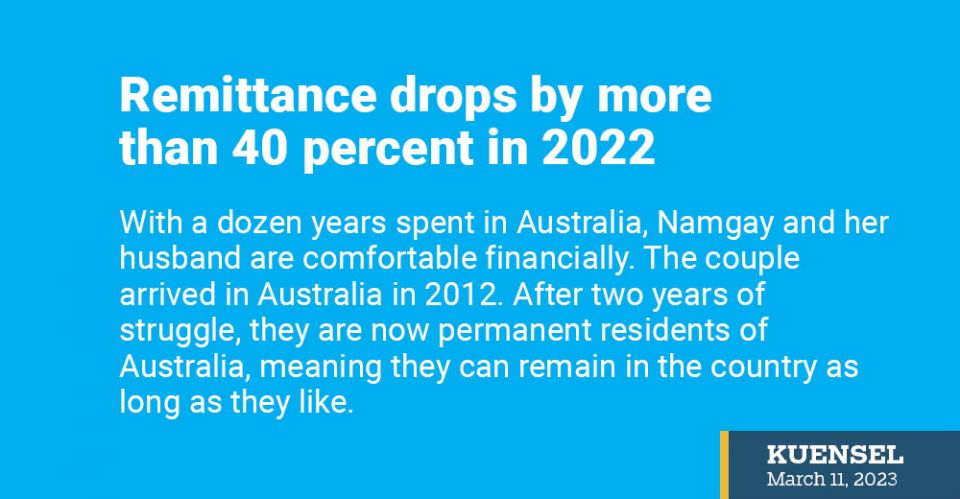
With a dozen years spent in Australia, Namgay and her husband are comfortable financially. The couple arrived in Australia in 2012. After two years of struggle, they are now permanent residents of Australia, meaning they can remain in the country as long as they like.
The couple is planning to build a house. To raise funds, they are mulling about selling their three-storey flat in Semtokha, Thimphu. They need money and one way is to sell their property in Bhutan and invest in a new building in Perth, W.A. The couple helped three relatives to come, study and work in Perth. She helped them financially. Another one is processing his visa.
Without her, her relatives would not have a house to stay in, pay fees in Australian dollars and buy a car to enable them to get to work.
In helping them, a lot of AUD Namgay saved was spent in Australia. She had not sent money home recently.
What Namgay is doing and helping her relatives is the trend that is leading to decline in remittance. This is evident from the records.
Inward remittance of convertible currencies (CC) or hard currencies has dropped by over 40 percent last year compared to 2021.
From Nu 8.06 billion (B) or USD 108.74 million (M) in 2021, inward remittance almost halved with Nu 4.69B or USD 61.66M coming in 2022.
The inward remittance contribution to the country’s total CC inflow stands at 21 percent and 23 percent in 2020 and 2021 respectively, according to the Royal Monetary Authority (RMA).
It contributed to 14 percent in CC inflow until November last year.
The other contributors to CC inflow are from loans and grants, the export of goods and services, and other transfers.
Both the major inbound remittance currency denominated in the USD and AUD has been declining. About 50 percent of the remittance denominated in AUD at Nu 4.03B or USD 71.84M in 2021 decreased by about 55 percent to Nu 1.82B or USD 34.66M last year. AUD worth Nu 5.34B was received in 2020.
Similarly, remittances in USD that contributed over 40 percent or Nu 3.4B (USD 45.86M) in 2021 decreased to Nu 2.34B or USD 29.94M last year.

Remittances in Singaporean Dollars, Canadian Dollars, and in Pound Sterling, EURO, and Japanese Yen also saw a drop.
Remittance in EURO was Nu 69.37M, Canadian Dollar at Nu 82.45M, Singaporean Dollar at 129.68M, Japanese Yen at Nu 67.61M, and Pounds Sterling at Nu 35.97M last year. These are largely from grants and aids.
Remittance in hard currencies helps improve foreign exchange reserves and reduces the deficit in the country’s current account by improving the balance of payments.
The decline in AUD, many say, was because Bhutanese in Australia are using the AUD within Australia to pay for tuition and visa fees, and invest in properties as many Bhutanese leave the country for Australia. With many finding it difficult to fulfil the requirements to borrow from banks in Bhutan, Bhutanese in Australia has become the new source of funding. “There is no hassle of borrowing or currency exchange while recovery is ensured once the loanee is brought to Australia,” said one preparing to leave for Perth, WA. “This is helping many Bhutanese without access to funds fulfil the dream of coming to Australia. Bhutanese in other countries must be doing the same.”
Hundreds of Bhutanese abroad, especially in Australia, are helping and encouraging their family members or relatives to join them as they see a sea of opportunities to earn in one year what they can in a lifetime in Bhutan.
Meanwhile, the country’s growing imports coupled with the rising inflation and appreciating USD against Ngultrum has put tremendous pressure on maintaining the foreign currency reserve.
The reserve at USD 773.2M as of November last year saw a decrease of USD 501.5M from the same month the previous year, according to the RMA’s provisional figure. It is adequate to meet 13.9 months of the essential imports requirement.
However, the government recently revised the foreign currency required for 12 months of essential imports. The revised essential import value for the normal period is USD 603M and USD 464M under the critical period from earlier USD 668M.
Another crucial currency, Indian Rupee (INR) reserve, fell to an all-time low of INR 8.7B in November last year. It is a decrease of INR 17.63B from the previous year. Given our huge import bill, INR reserves would be able to meet only 1.3 months of the country’s merchandise imports.
With over 80 percent of the imports from India and limited country’s export earnings, the government sells USD to buy INR.
To build up the country’s foreign currency reserve, Bhutanese abroad need to shell out more inward remittances through formal channels.
The remittance inflow saw an all-time high at Nu 1.45B in July last year when the exchange rate of USD against Ngultrum increased to Nu 79.62. The lowest inflow was Nu 290.66M in February last year when the exchange rate of USD against Ngultrum was Nu 75.03.
Encouraging inward remittance
To encourage inward remittance, the RMA has extended the two percent incentive until December this year. Beneficiaries will receive a cash incentive of 2 percent upon converting the remitted amount into Ngultrum.
A study by RMA also found that the incentive support scheme helped to reduce the cost of remitting USD from Australia to Bhutan to 2.09 percent. It was 3.8 percent lower than the average cost of remitting at 5.94 percent as per the World Bank’s September 2022 remittance prices worldwide report.












